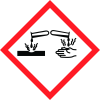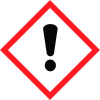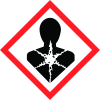Iodomethane
Sigma-Aldrich
Revision date : 2012-05-10




General Information
Revision date
2012-05-10
Product name
Iodomethane
CAS No.
74-88-4
Supplier name
Sigma-Aldrich
Emergency telephone
Americas Region
Icons in SDS
Company Information
Company name
Sigma-Aldrich
GHS Information
Signal word
Danger
Hazard Codes
Hazard statements (CLP)
H301+H311, H315, H317, H318, H330, H334, H335, H351, H412
Hazard statements
Code
Statements
H301+H311
Toxic if swallowed or in contact with skin
H315
Causes skin irritation
H317
May cause an allergic skin reaction
H318
Causes serious eye damage
H330
Fatal if inhaled
H334
May cause allergy or asthma symptoms or breathing difficulties if inhaled
H335
May cause respiratory irritation
H351
Suspected of causing cancer
H412
Harmful to aquatic life with long lasting effects
Precautionary statements
Code
Statements
P260
Do not breathe dust/fume/gas/mist/vapors/spray.
P273
Avoid release to the environment.
P280
Wear protective gloves/protective clothing/eye protection/face protection.
P284
[In case of inadequate ventilation] Wear respiratory protection.
P305+P351+P338
IF IN EYES: Rinse cautiously with water for several minutes. Remove contact lenses if present and easy to do - continue rinsing.
P310
Immediately call a POISON CENTER or doctor/physician.
Section 2
SECTION 2: Hazards identification
NFPA Rating Emergency Overview
2.3 Other hazards
Target Organ Effect, Toxic by inhalation., Toxic by ingestion, Toxic by skin absorption, Skin and respiratory sensitizer, Corrosive, Carcinogen Target Organs Central nervous system, Liver, Kidney, Thyroid, Lungs
Other hazards which do not result in classification
Vesicant., Rapidly absorbed through skin.
2.1 Classification of the substance or mixture
Acute toxicity, Oral (Category 3) Acute toxicity, Inhalation (Category 2) Acute toxicity, Dermal (Category 3) Skin irritation (Category 2) Serious eye damage (Category 1) Respiratory sensitization (Category 1) Skin sensitization (Category 1) Carcinogenicity (Category 2) Specific target organ toxicity - single exposure (Category 3) Chronic aquatic toxicity (Category 3)
Signal word
Danger
Hazard statements
H301 + H311 Toxic if swallowed or in contact with skin H315 Causes skin irritation. H317 May cause an allergic skin reaction. H318 Causes serious eye damage. H330 Fatal if inhaled. H334 May cause allergy or asthma symptoms or breathing difficulties if inhaled. H335 May cause respiratory irritation. H351 Suspected of causing cancer. H412 Harmful to aquatic life with long lasting effects.
Precautionary statements
P260 Do not breathe dust/ fume/ gas/ mist/ vapours/ spray. P273 Avoid release to the environment. P280 Wear protective gloves/ eye protection/ face protection. P284 Wear respiratory protection. P305 + P351 + P338 IF IN EYES: Rinse cautiously with water for several minutes. Remove contact lenses, if present and easy to do. Continue rinsing. P310 Immediately call a POISON CENTER or doctor/ physician.
Health hazards
3 * Flammability: 0 4 Fire: 0 Reactivity Hazard: 0
Physical hazards
0
Potential health effects
Inhalation Toxic if inhaled. Material is extremely destructive to the tissue of the mucous membranes and upper respiratory tract. Skin Toxic if absorbed through skin. Causes skin burns. Eyes Causes eye burns. Ingestion Toxic if swallowed.

